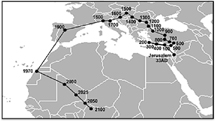From the War Department (now the Department of Defense) archives comes a 64-year-old military intelligence review titled “Islam: a Threat to World Stability” that inadvertently provides incredible insight into the challenges faced by Christians in today’s world. The intelligence estimate was presented verbatim in Parts 1 and 2 of this series. Part 3 updates and summarizes the intelligence estimate with the corresponding facts and figures for today.
The Muslim World Then and Now
 Massive changes have occurred between the Muslim world of 1946 and the Muslim world of today. The Muslim world still sprawls around half of the earth (see Figure 1), and its center straddles extremely rich oil reserves. States once marked by poverty, ignorance and stagnation have grown wealthy on oil. A middle class has developed, although the rich and poor are still far apart.
Massive changes have occurred between the Muslim world of 1946 and the Muslim world of today. The Muslim world still sprawls around half of the earth (see Figure 1), and its center straddles extremely rich oil reserves. States once marked by poverty, ignorance and stagnation have grown wealthy on oil. A middle class has developed, although the rich and poor are still far apart.
Muslims reside on all inhabited continents, with more than 60% of the global Muslim population in Asia and about 20% in the Middle East and North Africa. Fifty of the 232 countries have majority Muslim populations. Ten to thirteen percent (154 million to 200 million) of Muslims are Shia Muslims and 87-90% are Sunni Muslims. Most Shias (between 68% and 80%) live in just four countries: Iran, Pakistan, India and Iraq. One-fifth of the world’s Muslims (317 million) live in countries where Islam is not the majority religion. Over 75 percent of these live in five countries: India, Ethiopia, China, Russia and Tanzania.
The Growth of Islam
 Since 1946, the world Muslim population has increased by 400 percent, from 313 million (14% of 2.17 billion worldwide) to 1.543 billion (23% of the 2009 population of 6.8 billion). The African Muslim population has grown from 40 million in 1946 to 432 million in 2009. Contrast this growth with 287% in the Middle East, 333% in Turkey and 397% in Iran. The fastest expansion of Islam has been in Africa.
Since 1946, the world Muslim population has increased by 400 percent, from 313 million (14% of 2.17 billion worldwide) to 1.543 billion (23% of the 2009 population of 6.8 billion). The African Muslim population has grown from 40 million in 1946 to 432 million in 2009. Contrast this growth with 287% in the Middle East, 333% in Turkey and 397% in Iran. The fastest expansion of Islam has been in Africa.
Interestingly, Christianity is now also centered in Africa. Christianity has experienced a “meteoric rise” in Asia and Africa and a decline in Europe and the Americas.2 Figure 2 shows the profound southern shift in its geographical center of gravity of Christianity from inception projected through the end of the twenty-first century. Projected trends place Islam and Christianity on a collision course in Africa and India. If the trends continue, will the geographic proximity result in greater conflict or dialogue?
The Context of the 1946 Analysis
Intelligence Review No. 1 of 14 February 1946 noted, “If the Muslim states were strong and stable, their behavior would be more predictable. They are, however, weak and torn by internal stresses; furthermore, their peoples are insufficiently educated to appraise propaganda… Two basic urges meet head on in this area, and conflict is inherent in this collision of interests….The first of these urges originates within the Muslims’ own sphere. The Muslims remember the power with which once they not only ruled their own domains but also overpowered half of Europe… The Muslims intend, by any means possible, to regain political independence and to reap the profits of their own resources…The other fundamental urge originates externally. The world’s great and near-great powers covet the economic riches of the Muslim area and …the strategic locations of some of the domains.”
These two urges have played themselves out during the past 64 years in some surprising ways, which are discussed under the headings Islamism 1.0, Islamism 1.5, and Islamism 2.0.
Islamism 1.0. Spreading Islam by Violence
Historically, Islam has largely spread through conquest. The Arabic word jihad has a number of meanings: Islamic law recognizes two states of jihad against non-Muslims: 1) “Defensive jihad” occurs when non-Muslims invade in or near a Muslim country. Jihad is an obligation to repel non-Muslims. 2) “Offensive jihad” defines the communal obligation of proselytizing Islam until the entire world is subject to the rule of Islam, as this is Allah’s will. Had the Prophet not spread his religion by force, Islam would not exist.
The transnational nature of terrorism is especially appropriate for Islamists because Islam itself does not include a concept of nationhood. Loyalty to the umma (the community of Muslims) transcends all other loyalties: indeed, no other loyalties are allowable. As noted in the 1946 study, Western policies based upon an assumption of Muslim nationalism have been doomed from the outset by the West’s inability to perceive the totalitarian nature of Islam.
In summary, Islamism 1.0 “… attacks those perceived as obstructing its goal of a society ruled by a global caliphate and totally regulated by the Shariah (Islamic law).”4 Tactics encompass unlimited brutality, ranging from Koran-endorsed violence to totalitarian rule to genocide to terror. The Islamist’s pursuit of weapons of mass destruction must be taken seriously because they have repeatedly demonstrated they have no respect for human life or limitations of any kind.
However, their violence through terrorism, revolution, coup d’état and civil war are seldom effective in implementing Islamic rule by themselves.
Before examining Islamism 2.0, this article will examine combined hard and soft means currently used in non-Muslim majority countries to undermine established structures (referred to as “Islamism 1.5”).
Islamism 1.5. Spreading Islam “Peacefully” in non-Muslim Countries
Islam can also be spread through so-called “peaceful” means, notably through the four D’s”: Demographics, Dhimmitude, Dominance, and Demonization. This “peaceful” spread of Islam is aided by political correctness foisted upon Western nations by secular humanists through multiculturalism, replacement of Judeo-Christian traditions with legislated morality (e.g., hate crimes legislation and the fairness doctrine) and moral relativism.
Islamism 1.5 involves softening the kafir (non-Muslims) through public relations, lawsuits, political correctness, encroachment of shariah law and other Muslim devices (e.g., shariah-compliant financial instruments), and other legal means in concert with threats or selective violence as needed.
Muslims have become adept at forming public opinion. Working with their non-Muslim enablers, apologists and other “useful idiots,” they can win elections such as in Algeria (1992), Bangladesh (2001), Turkey (2002), Iraq (2005) and Gaza (2005). Once in power, they can move towards shariah law or otherwise impose their Islamism, as Hamas did in Gaza by forcing out Fatah in 1997, as Erdoan has been doing in shifting Turkey from their Western alignment toward the Islamic states, and as the United Kingdom has done in establishing separate shariah courts for Muslims in Britain.
Over the past three or so decades, the Muslim nations have learned to channel the economic and political power that their near monopoly status of world oil brings. Rather than conquer Western countries by force of arms as part of a defensive jihad,5 jihadists recognize that the nature of democratic societies is open to conquest through the offensive jihad of the Da’wa, the call to proselytize until the world is under Islam.6
Islamism 2.0. Working the System
The last decade has seen a major change in the strategic balance of the world, as the center of power shifts from the Atlantic to Asia due to the weakening of the United States and Europe and the growth of China and India. Not only are the natural resources of the Muslim world still in demand, but their geography enables them to capitalize upon the power shift.
In “Islamism 2.0,” Dr. Daniel Pipes writes, “Terrorism does physical damage and kills and intimidates, but it rarely over-turns the existing order…(I)f Ayatollah Khomeini, Osama bin Laden, and Major Nidal Hasan represent Islamism 1.0, (then) Recep Tayyip Erdoan (the prime minister of Turkey), Tariq Ramadan (a Swiss intellectual), and U.S. Representative[s Andre Carson (D-IN) and] Keith Ellison (D-MN) represent Islamism 2.0. The former kill more people but the latter pose a greater threat to Western civilization.”
The issue is Islam itself. The 1946 War Department study overlooked the true nature of Islam, which does not recognize political or geographical boundaries but only sharp division between Islamic and non-Islamic “houses”: “Dar alIslam” (The House of Islam) and “Dar alHarb” (The House of War).7
Another Islamism 2.0 phenomenon used by Islamist organizations to further their objectives is the promotion and exportation of shariah-compliant finance, now commonly referred to as SCF. This “Stealth Jihad” is being conducted against every non-Muslim country.
Popularization of Islam and Muslim Culture
Due to both progressive and Muslim influences, recent decades have seen an explosion of information about Islam and Muslim culture in popular Western media and education. Most European and U.S. school curricula include study of Islam and Muslim history.
The processes of globalization have created new media and made widely varied content available to Muslims throughout the world, influencing how they see themselves as part of a wider global community of Muslim believers (umma).
As the older sectors of the Muslim media develop, Muslims embrace new transnational technologies and means of disseminating information. Google searches for “Islam” and “Muslim” respectively found 109 million and 57 million web pages. The Internet provides a rich resource to construct Muslim identities and ideologies. The Internet is a key tool in Arab missionary work and is a major factor in conversions.8
Conclusions
The 64-year-old military intelligence review from defense archives entitled “Islam: a Threat to World Stability” is a remarkably useful starting point for reviewing the recent history of Islam. Since 1946, much of the Muslim world has been transformed by resource wealth from poverty and stagnation into vibrant, wealthy nations that try to overreach economically just as wealthy Western nations do.
However, Muslim nations without an abundance of petroleum or mineral wealth remain trapped in poverty, and turmoil, as do some with wealth.
While an educated and skilled Muslim middle class has developed, many individuals in the Islamic world remain trapped in poverty and others are desperate to find better opportunities for themselves and their families. This has led to an exodus to non-Muslim countries under a cloak of respectability (or illegal migration) and the development of a new Muslim diaspora.
Unemployment of young Muslims is a major worldwide problem in both Muslim and non-Muslim countries. Under-employment, restlessness and a frustrated sense of entitlement make fertile recruiting grounds for extremist organizations. Muslim extremists are resident in all continents, and there is a developing trend in Western nations of “home-grown” Muslim terrorists.
America and non-Muslim nations have been attacked by Islamist extremism for years, but until recently, it has not been clear specifically by whom or precisely for what. We can now discern three distinct strategies:
1) Islamism 1.0 attempts to spread Islam by violence through conventional warfare—with or without weapons of mass destruction—or through unconventional means like terrorism or insurgency.
2) Islamism 1.5 attempts to spread Islam “peacefully” within specific non-Muslim countries, using tools provided by their apologists, enablers and co-collaborators within the Liberal-Muslim Axis, such as political correctness and “partial” implementation of Islamic law in the non-Muslim state.
3) Islamism 2.0 is far more insidious. Its adherents operate transnationally to achieve the same goals, relying upon the cravenness, greed and avarice of Western politicians, government agencies, academics and businesspeople to facilitate the implementation of practices based upon shariah law.
Western nations are in a fight to the death with Islamism, a totalitarian political ideology that, like Nazism or Communism before it, is determined to destroy freedom and the people who love it. The goal is to establish shariah not merely as the supreme law of the land, but as the supreme law of the world.
Alas, most people in non-Muslim nations not under direct personal threat do not perceive the threat. However, the authors of the War Department military intelligence review certainly were aware and provided a warning.
Notes:
The Green Editor. “World Muslim Population Map.” 30 June 2009. Wikipedia. 22 September 2009 <http://upload.wikimedia.org/wikipedia/commons/4/40/Muslim_distribution.png >.
Todd M. Johnson and Sun Young Chung, “Tracking Global Christianity’s Statistical Centre of Gravity, AD 33-AD 2100,” International Review of Mission, Vol. 93, No. 369 (April 2004), pp. 166-181.
Ibid.
Pipes, Daniel. “Islamism 2.0 - an even greater threat.” 25 November 2009. Jerusalem Post. 27 November 2009 http://www.danielpipes.org/7770/islamism.
al-Thaani, Jumaada. “The aims of Al-Qaida.” Deen Al-Islam. June 2008.
Campbell, Andrew. “Australia’s Islamic fundamentalist Sheikh Mohammed Omran’s mystery train.” CI-CE-CT.com November 11, 2003.
M. Hamidullah’s Muslim Conduct of State Hyderabad-Deccan, 1942. P. 77. mentions a third (“Dar al-Ahd”) with which treaty obligations and relations (temporarily) exist.
Ahmed, Sameera Tahira. “Young Muslims and Muslim Media in Britain.” European Media Technology and Everyday Life Network Conference. London: London School of Economics and Political Science, 24 April 2003.





